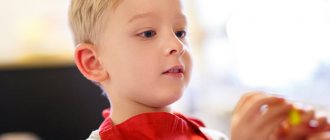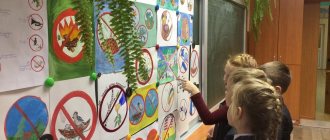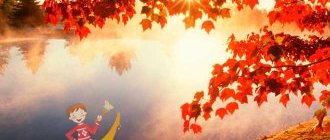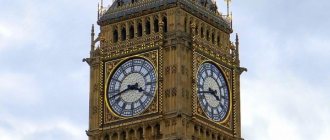For most of the day, the child is in a static position, that is, sitting:
- at school during classes;
- at home while doing homework, reading, watching TV or playing computer games.
In this case, the child bears a major physical load. Static load conflicts with the physical development of the child. As a result, the development of the disease.
The child’s performance decreases, negative emotions appear, and his health worsens. The child complains of a headache. Some of the children begin to violate the rules of conduct in class. Therefore, when the first signs of overwork are detected in children, it is necessary to take breaks during which the children can perform simple physical exercises. Such breaks during the lesson (physical education minutes) help improve the functioning of the brain, restore muscle tone that maintains correct posture, and relieve tension from the organs of vision and hearing, and from fingers tired from writing.
Physical education includes 3-4 exercises that are familiar to children and easy to perform. Each exercise is performed 3-4 times at an average pace.
Physical education sessions are usually held after 20-30 minutes. work. The duration of physical education is 2-3 minutes. Exercises should be selected in such a way that during the day various muscle groups of children are purposefully loaded and relaxed: shoulder girdle, back, hip joints. It is necessary to include in the complex exercises for relaxation, breathing exercises, and exercises for coordination of movements.
Organizing physical education minutes involves preparing the room and students, who, to perform the exercises, must close books and notebooks and put them in the middle of the desk, unbutton their collars. The attendant opens a window or window. It’s good when students know how to spend physical education minutes on their own. The person on duty or the physical trainer can conduct physical education minutes. It is recommended to perform the exercises standing near a desk or sitting at a desk.
To make the process of doing physical exercises interesting for children, it is necessary to change the exercises from time to time (every 2-3 weeks), perform them to music, and include dance movements.
Children enjoy physical education sessions that are accompanied by poetic texts. To ensure that children do not lose their breathing rhythm, their movements are precise and strong; during such physical education sessions, the teacher recites the text, and the children perform the exercises.
Types of physical education minutes
All physical education minutes
can be divided
into three groups
:
Read also: Stopxd;words in sexxd;games Newspaper Ya
1. Physical education sessions, which are held in the second half of the lesson
when children are tired, or between different types of work, when it is necessary to switch the attention of preschoolers from one activity to another in order to increase the efficiency of learning the material and to improve the health of children.
Such physical education lessons include poems that include exercises that cover large muscle groups. These are exercises related to stretching and straightening the spine; easy running, walking in place, jumping, squats at a fast pace, bending to the sides, swinging arms, etc., accompanied by text, usually in poetic form. The heroes and characters of such physical education minutes are mice, a black cat, a hamster, a grasshopper, a hare, bears, a rooster, a stork, a beetle, a crow; swimmers; trees, etc.
2. Physical education sessions that include exercises for the muscles of the hands
. They are used to rest children’s fingers after holding a pencil or brush for a long time in fine arts classes in all kindergarten groups.
Video physical exercises for 4th grade children
For variety, you can use video physical education minutes in 4th grade lessons, when the teacher demonstrates them on the screen, children repeat the movements of the characters in the video and perform fun exercises to the music. Physical exercises are carried out in a light form in the form of a warm-up.
Physical school
Download: Physical education Size: 17.3 Mb
Physical education lesson for children “Shark Baby”
Download: Physical education Size: 13.2 Mb
Physical exercise “Dance with acceleration Let’s dance”
Download: Physical exercise “Dance with acceleration Let’s dance” Size: 26.1 Mb
Motor-speech physical exercises
Breathing and articulation gymnastics
Read also: Should you join a trade union?
These are exercises for alternating sounds, alternating breathing, long inhalation and exhalation, exercises: “ Blow out a candle ”, “ Imitating animals ”, “ Sound around ” - with the help of sounds, children demonstrate: rain, the flight of a bumblebee, the flight of a helicopter or an airplane passing nearby car, etc.
“ Foot flexion ” is an exercise that is responsible for speech and language. With the help of these exercises, the upper and lower sections of the lungs are affected, saturating them with oxygen, and reducing tension.
Physical education games for 4th grade
This finger Raise your left hand with your palm facing you and, in accordance with the text, bend the fingers of your left hand in turn with your right hand, starting with the little finger.
This finger wants to sleep, This finger wants to jump into bed! This finger took a nap. This finger has already fallen asleep. Hush, little finger, don't make noise, don't wake up your brothers... Little fingers stood up, hurray! It's time for them to go for a walk. Palms The teacher asks a question: - Where are your palms? - Here - here - here! Children show hands folded into fists. And the fingers live in the palms! They open their fists and show their fingers in motion. The fingers worked, They were not lazy, They sculpted and sculpted, The fingers bent and unbent, imitation of sculpting. Drawing, Imitation of drawing. They built and built, Imitation of construction movements, for example, laying bricks. Well played! And then, and then, And then you got tired! Shaking your hands, relaxing your fingers.
Scarlet flowers The palms are connected in the shape of a tulip, the fingers slowly open, then the hands are gently swayed, then the fingers are slowly closed, again taking on the shape of a bud, and the head of the flower is swayed. Our scarlet flowers open their petals. The breeze breathes slightly, the petals sway. Our scarlet flowers close their petals, quietly fall asleep, shake their heads.
Five babies One baby is swinging in the garden, Put one finger forward and then show them how the swing swings. Two kids are swimming in a pond, show two fingers and then imitate the movements of swimmers with their hands. Three babies are crawling towards the doors in the apartment, show three fingers and imitate crawling movements. And there are already four knocking on this door. Show four fingers and imitate knocking on the door. The other five are also okay: Show all the fingers of the other hand. They are having fun, playing hide and seek. Covering your face with both hands means “hiding.” Where they are hiding is clear and no brainer, Hands clasped in front of the chest, fingers open (“hedgehog”). But I closed my eyes and said: Close my eyes with one hand. “One, two three... two, three, four, five... Count and at the same time show the required number of fingers on your hand. Well, beware: I’m coming to look!” The index finger is raised up - “warning”, then imitation of “sneaking”.
Bunnies and a wolf In the forest, in a house, there lived a hare with two little bunnies. The index and middle fingers of both hands are raised up - these are the ears; the remaining fingers are gathered into a fist - the torso. One morning the little bunnies took their favorite drums and ran into the forest. They began to drum loudly, loudly throughout the forest. The bent little and ring fingers—the drum sticks—hit the pad of the thumb—the drum. Straight ears at the top are pressed against each other. And it must have happened that a hungry wolf was prowling near those places. Place the palms of both hands together; large straight fingers spread to the sides - these are the ears of a wolf; Bend the upper phalanges of the index fingers so that the nails touch - this is the forehead of the wolf. He heard a noise and jumped out into the clearing. The tightly grouped straight middle and ring fingers are the nose of the wolf; two little fingers pressed to each other move down - this is the mouth of a wolf. The wolf moves its ears, sniffs, opens and closes its mouth. All fingers are moving. The poor little bunnies abandoned the drums and huddled close to the birch tree, unnoticeable, only their ears trembling little by little with fear. Children press their fists (“bunnies”) to their chests, their “ears” perform small oscillatory movements - they flutter. The wolf was confused: “Where are the hares? They were just here and suddenly disappeared. Oh, and the cunning ones, they tricked the old wolf again! Well, hares, wait a minute! I’ll find justice for you!” — He growled his threats and wandered into the forest. As soon as the wolf disappeared, the bunnies jumped out and forgot their fears and began to laugh at each other. One says: “You were so afraid of the wolf that your ears bowed to the ground!” - "No! - says another. “My ears did not bow, but your ears crouched in fear.” One of the “hares” demonstrates these and other movements, and the second, as if mechanically, begins to repeat, but, having come to his senses, immediately refutes the slander and provides evidence to incriminate his comrade. - No, my ears didn’t crouch in fear, but your ears hid behind each other! - No, my ears weren’t hiding behind each other, but your ears were running after each other from top to bottom and top to bottom! - No, my ears didn’t run around like that, but your ears knocked against each other out of fear! And so the hares got wild, shouted that they stood up on their ears and went home on their ears. Mom came out and said: “What is this? The ears are dirty again, did you walk on the ears again? Come on, quickly clean your ears with your paws!” The hares began to clean their ears with their paws. “Come on, I’ll glue your ears together so you don’t play around with them anymore. Take your drums and learn to drum well so that the bear-circus director invites you to be a drummer!”
So, what is a physical education minute and what do you eat it with?
A physical exercise is a short warm-up that takes place right in class. It helps students to distract themselves, relax and reorganize for the next stage of work. Therefore, most often physical training is carried out in the middle of the lesson, if necessary - more than once.
First of all, it is important to know that for normal health in the classroom, all sanitary standards must be observed:
- distances between desks and blackboard,
- thermal regime,
- focusing on objects in different parts of the class,
- sizes of desks and chairs,
- cleanliness of the premises,
- lighting intensity and much more.
Only when the classroom meets all standards can you be sure that the time that students spend in it will benefit them.
It is known that the muscles of the fingers, eyes and spine get tired the fastest, especially in children. Guys who have just learned to write think that they need to squeeze the pen tightly to make the letters straighter. In addition, physical education lessons at school compensate for only 11% of physical activity for children. And old, unpainted boards on which you can’t see anything are unlikely to train your eye muscles.
Physical education lessons in art lessons, grade 4
Physical education lessons for children in art lessons in 4th grade:
Raise your hands all - this is “one”, Turn your head - this is “two”, Hands down, look forward - this is “three”, Turn your arms wider to the sides to “four”, Press them forcefully to your shoulders - this is “five” . All the guys sit down quietly - this is “six”. Let's sit and relax, and then we'll start drawing.
It's frosty and windy outside, Children are walking in the yard. (we walk in place) The hands are warmed, (claps hands) The hands are rubbed. (three hand in hand) So that our feet don’t get cold, Let’s stomp a little. (stomp our feet) We are not afraid of the frost, we dance merrily. (dance)
Seagulls are circling above the waves, Let's fly after them together. Splashes of foam, the sound of the surf, And above the sea - you and I! (We wave our arms like wings) We are now sailing on the sea And frolicking in the open air. Have fun rowing and catch up with dolphins. (We make swimming movements with our hands)
A fairy tale will give us a rest. Let's take a rest and hit the road again! Malvina advises us: “The waist will become like an aspen, If we bend left and right ten times.” Here are Thumbelina's words: - So that your back is straight, Rise on your tiptoes, As if reaching for flowers. One, two, three, four, five, Repeat again: One, two, three, four, five. Little Red Riding Hood's advice: - If you jump and run, you will live for many years. One two three four five. Repeat again: One, two, three, four, five. The fairy tale gave us a rest! Have you rested? On the road again!
Physical education lessons for younger schoolchildren
A special feature of physical education for younger schoolchildren is that they can become a super-useful break during school lessons. They can be performed together with children right in the classroom, standing up from their desks. Moving to the rhythm of the poem, children will “wake up” and activate brain activity to absorb the “granite of science”)))
Read also: Questions in Instagram stories
Many poems also help reinforce the material covered.
Watch
Tick-tock, tick-tock, who in the house can do that? This is a pendulum in a clock, Beats every beat (Tilts left and right.) And in the clock sits a cuckoo, She has her own hut. (Children sit down in a deep squat.) The bird will spend time, hide behind the door again, (Squats.) The arrows move in a circle. They don't touch each other. (Rotate your body to the right.) You and I will turn counterclockwise. (Rotate your body to the left.) And the clock goes and goes, (Walks in place.) Sometimes it suddenly lags behind. (Slow down the pace of walking.) And sometimes they are in a hurry, As if they want to run away! (Running in place.) If they are not turned on, then they completely stand up. (Children stop.)
Monkeys
(group physical education, children repeat everything that is said in the poem)
We are funny monkeys, We play too loud. We all stomp our feet, we all clap our hands, we puff out our cheeks, we jump on our toes.
Physical education lessons in technology lessons in 4th grade
Physical exercises for children during technology lessons in the 4th grade: Be careful, the wind came out of the gate, (arms up and swing your arms left and right) Knocked on the window, (knock on the desk with your fingers) Ran along the roof, (fiddle with your fingers on the desk) Gently shook the bird cherry branches , (raise your arms up, swing your arms left and right) Sparrow scolded his acquaintances for something. (shake a finger) And, proudly spreading his young wings, he flew somewhere mixed with dust. (waving his arms)
The flower was sleeping and suddenly woke up, (Torso to the right, to the left) Didn’t want to sleep anymore, (Torso forward, backward) He moved, stretched, (Hands up, stretch) Soared up and flew. (Hands up, right, left) The sun is just waking up in the morning, The butterfly is circling and curling. (Spin around)
If you want to be healthy always, repeat after me then. We all stretched forward, stretching our fingers. One, two, three, four, five Well done to all the girls and boys. Now tilt your head from side to side. Live up, don’t be lazy, and everything will be great. Start rotating your shoulders to drive away fatigue. And don’t visit then, Your body is weak. Everyone always needs a workout. Well guys, did you have a rest? Yes!
Three cats were walking along the roof. Three cats were walking along the roof, Vasily's three cats. (Walking) Three tails were raised straight into the blue sky. (Raising hands) The pussies sat on the ledge, Looked up and down. (Squat) And the three cats said: - Beauty! Beauty! (Clap your hands)
Creative physical exercises
Gymnastics of the mind
The use of games for development, logical thinking, cognitive processes, ability to make decisions, imagination, perception, attention, memory. This includes mini-quizzes, crosswords, riddles, and puzzles. Mental gymnastics includes exercises to improve cerebral circulation - these are motor actions (bending and turning the head) + breathing exercises.
During the exercises, there is a mechanical effect on the walls of blood vessels, facilitating and increasing the intensity of mental activity, dilating the blood vessels of the brain and increasing cerebral circulation, increasing their elasticity.
Unusual movements
Tasks like: how a pedestrian can move from a mountain or up a mountain, on an uneven road, or how a ship sails in a storm and in a calm.
Role-playing games
Games such as role-playing games introduce preschoolers into the world of adults. Most often, physical exercises are performed in poetry.
Pantomime gymnastics
Methodology for conducting physical exercises in children. Pantomimic gymnastics is associated with imitation of birds or animals.
“ Owl ” is an exercise to relieve fatigue from the muscles of the neck and visual apparatus.
Starting position - grab and squeeze the left shoulder muscle with your right hand, turn your head and look over your shoulder. We pretend to be an owl, clap our eyes, take a breath, and as we exhale we say “uh.”
When performing this exercise, there is an impact on the upper and lower sections of the lungs, saturating them with oxygen, reducing tension, relaxing the muscles of the neck, shoulder girdle, spine, restoring the vocal cords and relieving fatigue from the visual apparatus.
Physical education lessons for 4th grade in verse
We, tourists, are on our way. Walk your feet more cheerfully, exhale easier, inhale deeper. The path is not close, not far. A stream flows ahead, Let's jump over quickly.
Bullfinches (swans) are flying, flapping their wings, waking up (flying) over the water, shaking their heads. They know how to hold themselves straight and proud, and sit quietly and silently on branches.
March on the spot - slowly, As the weather is good, we are not afraid of the frost, We catch the snow, clap our hands. Hands to the sides, at the seams. There's enough snow for you and us.
Easy jumps. Soft steps. That's all the charging. Quiet landing.
In order to complete the tasks, we need to rest a little. Well, guys, let's stand together. You need to shake the bones. Hands up, bent back. Now let's do the bends - Are you all ready for the exercise? One, two, three, four, five, Now keep your backs straight. We will walk on the spot. Let's all sit quietly and close our eyes. Remember everything you repeated without my prompting.
Mowers There is silence all around, The mowers went out into the meadow. Swing your scythe back and forth, Do “one” and do “two.” (Children make movements with straight arms to the left and right with a rotation of the body).
Blacksmith Hey, well done blacksmith, My stallion is lame. You shoe him again. Why not shoe it? Here's a nail, here's a horseshoe. One, two - and you're done. (Children walk, leaning first on one leg, then on the other, spread their arms to the sides, strike each word in front of them in the air with their fists - 8 times in total)
Maple The wind quietly shakes the maple, tilts to the right, to the left: Once - tilt and twice - tilt, The maple leaves rustled. (Feet shoulder-width apart, hands behind the head. Torso tilts to the right and left)
At the parade Like soldiers at a parade, We walk row by row, Left - once, left - once, Look at us, everyone. Everyone clapped their hands - Together, have fun! Our feet started pounding - Louder and faster! Let's hit you on the knees - Hush, hush, hush. We raise our arms, our arms – Higher, higher, higher. Our arms began to spin and fell again. We spun around and stopped.
The hares are jumping: Skok-skok-skok! Yes, on a little white snow. They crouch down and listen to see if a wolf is coming. Once - bend over, straighten up. Two – bend over, stretch. Three - clap your hands three times. Three nods of the head.
Pump Now we turn on the pump and pump water from the river. Left - one, right - two. Water flowed in a stream. One, two, three, four - We did a good job.
River We went down to the fast river, bent down and washed ourselves. One, two, three, four, That's how nicely refreshed we were. And now we swam together. You need to do this with your hands: Together - once, this is breaststroke. One, the other is a rabbit. All of us, as one, swim like a dolphin. We went ashore and went home.
Here are my helpers, turn them any way you want. One, two, three, four, five, they can’t sit again. They knocked and turned and didn't want to work. This finger wants to sleep. This finger jumped into the bed, this one took a nap next to it. This finger has already fallen asleep. And the other one has been sleeping for a long time. Who else is making noise here? Hush, hush, don't make any noise. Don't wake up your fingers. (in a whisper) The clear morning will come, the red sun will rise, (louder) the birds will begin to sing, the fingers will begin to rise. (loudly) Wake up, kids! It's time for the fingers to go to school. (everyone raises their hands with open palms)
There are so many green Christmas trees, so many bends we can do. How many circles we have here, How many jumps we will make. (There are Christmas trees and circles on the board)
How many bunnies we have, We'll jump that many times. How many sticks to the point, How many will we stand on our tiptoes. How many dots will there be in the circle, How many times will we raise our hands.
Motor-speech physical exercises for 4th grade
Arms to the sides and up. We repeat together. The student has been sitting too long - he needs to warm up. We will first shake our heads in response to everyone: NO! Energetically, as always, we’ll shake our heads: YES! So that your knees don’t creak, So that your legs don’t hurt, We squat deeply, We rise easily. One, two, three, we take a step. The teacher gives a sign. This means that it’s time for us to sit down at our desks. Hooray! Let's stop being lazy, Let's work again.
- How are you? - Like this! (Shows thumb) - How are you going? - Like this! (“Walk” with two fingers on the palm) - Are you running? - Like this! (They bend their arms at the elbows and show how they work with them when running) - Do you sleep at night? - Like this! (They put their hands under their cheeks, and their head on them) - How do you take it? Like this! (They make grasping movements with their hands) - Will you give it? - Like this! (They make movements with their hands. As if they are giving something) - How naughty are you? - Like this! (They puff out their cheeks and lightly slap them with their palms) - Are you threatening? - Like this! (they shake their finger at their neighbor)
One two three four. We studied a lot, learned a lot, and got a little tired. We roll our eyes and shake our heads. They stretched their arms and legs, took a good breath, and bent over once and twice. Are you feeling dizzy? Well, since everything is okay with you, let's work in the notebook.
To always be in order, we do exercises in the morning. We rub our cheeks and warm them up, we also warm up our necks, we need to rub our ears, look to the right and left.
Let's fasten our hands behind our necks, And there will be no more boredom, We'll turn to the right, to the left, We'll all smile broadly, And we'll repeat the tilt back and forth twice. One, two... One, two...
Swans fly, flapping their wings. They bent over the water and shook their heads. They know how to stand straight and proud, and sit on the water very silently.
We put our hands on the belt, tilt our body to the right, tilt it to the left too, we repeat everything twice. One, two... One, two... We will clap our hands twice, One, two... We will also clap our knees, One, two... And then we will sit down and stand, We repeat everything twice. One, two... One, two...
We raise our hands up, and then lower them, repeat once on the heels, rising on the toes. One, two, three, four, five, Let's continue.
Inhale and exhale... Smile! Are the kids all awake? Well, of course, we woke up, everyone smiled widely, and everyone was ready to gain knowledge together again.
We go for firewood and carry a saw with us. Together we saw a log, it is very thick. To light the stove, you need to cut a lot. So that the firewood can fit into the stove, we will cut it into planks. Now let’s collect them and take them to the shed. After hard work, you always have to sit.
Like our animals, their paws are merrily knocking: Top-top-top, top-top-top, And the legs are tired, They clap their palms: Clap-clap-clap, clap-clap-clap, And then the animals dance side by side in a squat. And once they start running, no one can catch them.







